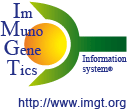Citing this page: Lefranc, M.-P. and Lefranc, G. Human Gm, Km and Am allotypes and their molecular characterization: a remarkable demonstration of polymorphism In: B. Tait, F. Christiansen (Eds.), Immunogenetics, chap. 34, Humana Press, Springer, New York, USA. Methods Mol. Biol. 2012; 882, 635-680. PMID: 22665258
A2m allotypes
A2m allotype determination by RFLP
A2m allotypes can be determined at the DNA level by restriction fragment length polymorphism (RFLP) using appropriate restriction enzymes [1]. There are two A2m allotypes A2m (1) and A2m (2) which correspond to two allelic forms, α2 A2m1 and α2 A2m2. The amino acid responsible for the A2m (2) allotype is encoded by nucleotides which are part of an EcoRI restriction site. Due to a nucleotide substitution, this site is absent in the A2m1 allele. Thus, whereas the restriction enzyme PstI yields two fragments containing the IGHA1 (1.2 kb) and IGHA2 (2 kb) genes [2,3] when DNAs are probed with a Cα probe, double digests EcoRI - PstI show two different patterns: one similar to the PstI one for the A2m1 allele and the other with a new 0.9 kb band for the A2m2 allele due to the existence of the EcoRI site [1].
The determination of A2m alleles by RFLP is particularly useful when reagents are not readily available for the serological determination of the allotypes. Moreover it is the only way to identify A2m alleles when no serum is available (for instance cell lines).
| [1] | Lefranc, M.-P. and Rabbitts, T. H., Nucl. Acids Res., 12, 1303-1311 (1984), PMID: 6322103, LIGM:29. |
| [2] | Flanagan, J.G. and Rabbitts, T. H., Nature, 300, 709-713 (1982), PMID: 6817141. |
| [3] | Lefranc, M.-P. et al., Nature, 300, 760-762 (1982), PMID: 6817143, LIGM:20. |



